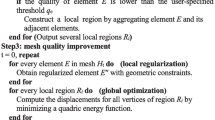Abstract
Mesh adaptation is widely used in numerical simulations to improve the accuracy and efficiency of the solutions. This paper introduces a physics-based hexahedral mesh adaptation method based on posterior-error estimation. First, we determine the regions to be refined based on the Riemannian metric field, which is calculated according to the analysis result on the coarse hex mesh. Second, the quad sets to be inserted by sheet inflation operations are determined based on the graph cuts algorithm, which considers the topological quality and the adaptation requirements. Finally, the mesh quality is improved with a size-preserving mesh optimization method that considers both the element shape and mesh size. Experimental results for the mechanical parts verified the effectiveness of the proposed method.


















Similar content being viewed by others
References
Frey P-J, Alauzet F (2005) Anisotropic mesh adaptation for CFFD computations. Comput Methods Appl Mech Eng 194(48–49):5068–5082
Li X, Shephard MS, Beall MW (2005) 3D anisotropic mesh adaptation by mesh modification. Comput Methods Appl Mech Eng 194(48–49):4915–4950
Zhang YJ (2018) Geometric modeling and mesh generation from scanned images. Chapman and Hall/CRC, Boca Raton
Yu Y, Liu JG, Zhang YJ (2021) Hexdom: polycube-based hexahedral-dominant mesh generation. arXiv:2103.04183
Yu Y, Wei X, Li A, Liu JG, He J, Zhang YJ (2020) Hexgen and hex2spline: polycube-based hexahedral mesh generation and spline modeling for isogeometric analysis applications in ls-dyna. arXiv:2011.14213
Hu K, Zhang YJ, Xu G (2018) CVT-based 3D image segmentation and quality improvement of tetrahedral/hexahedral meshes using anisotropic Giaquinta-Hildebrandt operator. Comput Methods Biomech Biomed Eng Imaging Vis 6(3):331–342
Hu K, Zhang YJ (2016) Centroidal Voronoi tessellation based polycube construction for adaptive all-hexahedral mesh generation. Comput Methods Appl Mech Eng 305:405–421
Zhang Y, Liang X, Xu G (2013) A robust 2-refinement algorithm in octree or rhombic dodecahedral tree based all-hexahedral mesh generation. Comput Methods Appl Mech Eng 256:88–100
Qian J, Zhang Y (2012) Automatic unstructured all-hexahedral mesh generation from b-reps for non-manifold cad assemblies. Eng Comput 28(4):345–359
Zhang Y, Bajaj C (2006) Adaptive and quality quadrilateral/hexahedral meshing from volumetric data. Comput Methods Appl Mech Eng 195(9–12):942–960
Xu K, Gao X, Deng Z, Chen G (2017) Hexahedral meshing with varying element sizes. In: Computer graphics forum, Wiley Online Library, vol 36, pp 540–553
Quadros WR, Shimada K, Owen SJ (2004) Skeleton-based computational method for the generation of a 3D finite element mesh sizing function. Eng Comput 20(3):249–264
Tchon K-F, Khachan M, Guibault F, Camarero R (2005) Three-dimensional anisotropic geometric metrics based on local domain curvature and thickness. Comput Aided Des 37(2):173–187
Löhner R, Parikh P (1988) Generation of three-dimensional unstructured grids by the advancing-front method. Int J Numer Methods Fluids 8(10):1135–1149
Cunha A, Canann S, Saigal S (1997) Automatic boundary sizing for 2D and 3D meshes. ASME Appl Mech Div Publ AMD 220:65–72
Owen SJ, Saigal S (1997) Neighborhood-based element sizing control for finite element surface meshing. In: 6th international meshing roundtable Proceedings, pp 143–154
Pirzadeh S (1993) Structured background grids for generation of unstructured grids by advancing-front method. AIAA J 31(2):257–265
Yerry MA, Shephard MS (1983) A modified quadtree approach to finite element mesh generation. IEEE Comput Graphics Appl 3(1):39–46
Zhu J, Blacker TD, Smith R (2002) Background overlay grid size functions. In: IMR, pp 65–73
Quadros WR, Vyas V, Brewer M, Owen SJ, Shimada K (2010) A computational framework for automating generation of sizing function in assembly meshing via disconnected skeletons. Eng Comput 26(3):231–247
Zienkiewicz OC, Zhu JZ, Gong NG (1989) Effective and practical h-p-version adaptive analysis procedures for the finite element method. Int J Numer Methods Eng 28(4):879–891
Verfurth R (1984) A combined conjugate gradient-multi-grid algorithm for the numerical solution of the stokes problem. IMA J Numer Anal 4(4):441–455
Eriksson K, Johnson C (1995) Adaptive finite element methods for parabolic problems IV: nonlinear problems. SIAM J Numer Anal 32(6):1729–1749
Eriksson K, Johnson C (1995) Adaptive finite element methods for parabolic problems V: long-time integration. SIAM J Numer Anal 32(6):1750–1763
Zienkiewicz OC, Zhu JZ (1992) The super convergent patch recovery and a posteriori error estimates. Part 1: the recovery technique. Int J Numer Methods Eng 33(7):1331–1364
Zienkiewicz OC, Zhu JZ (1992) The super convergent patch recovery and a posteriori error estimates. Part 2: error estimates and adaptivity. Int J Numer Methods Eng 33(7):1365–1382
Schneiders R, Schindler R, Weiler F (1996) Octree-based generation of hexahedral element meshes. In: Proceedings of the 5th international meshing roundtable. Citeseer
Zhang H, Zhao G (2007) Adaptive hexahedral mesh generation based on local domain curvature and thickness using a modified grid-based method. Finite Elem Anal Des 43(9):691–704
Borden MJ, Benzley SE, Mitchell SA, White DR, Meyers RJ (2000) The cleave and fill tool: an all-hexahedral refinement algorithm for swept meshes. In: IMR, pp 69–76
Tchon K-F, Dompierre J, Scamarero R (2004) Automated refinement of conformal quadrilateral and hexahedral meshes. Int J Numer Methods Eng 59(12):1539–1562
Boykov Y, Veksler O, Zabih R (2001) Fast approximate energy minimization via graph cuts. IEEE Trans Pattern Anal Mach Intell 23(11):1222–1239
Wang R, Ding M, Wu H, Zheng Z, Gao S (2020) Optimization design method of complex sheet insertion operation of hexahedral mesh. J Comput Aided Des Comput Graphics 32(5):846–856
Gao X, Panozzo D, Wang W, Deng Z, Chen G (2017) Robust structure simplification for hex re-meshing. ACM Trans Graph 36(6):1–13
Gao X, Shen H, Panozzo D (2019) Feature preserving octree-based hexahedral meshing. Computer graphics forum, vol 38
Acknowledgements
The authors are very grateful to the financial supports from NSF of China (61802211) and QiangJi Program (TC190A4DA/3).
Author information
Authors and Affiliations
Corresponding author
Additional information
Publisher's Note
Springer Nature remains neutral with regard to jurisdictional claims in published maps and institutional affiliations.
Rights and permissions
About this article
Cite this article
Shen, C., Gao, S. & Wang, R. Hexahedral mesh adaptation based on posterior-error estimation. Engineering with Computers 38, 4337–4348 (2022). https://doi.org/10.1007/s00366-021-01581-7
Received:
Accepted:
Published:
Issue Date:
DOI: https://doi.org/10.1007/s00366-021-01581-7




